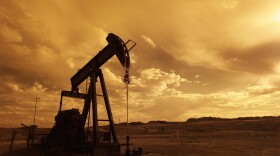Since 2020 the state has allowed oil and gas producers to temporarily stop running pumps because the pandemic economy was particularly bad for business. But despite the rebound in oil prices, there are still more than 1,000 wells sitting idle.
Reporter Jerry Redfern from Capital & Main talked to KUNM about uncovering this story, including how a major Trump donor and associate of Vladimir Putin is now the top beneficiary of the program and how a couple dozen state regulators have the seemingly impossible job of trying to track the industry.
JERRY REDFERN: I heard about it three months or so ago, and at that point gas prices were very high, oil prices were very high. It didn't seem like there should be any reason whatsoever that any sort of company would want to keep a well offline if they could have it online.
KUNM: This well-shutting program was supposed to hold oil companies and gas companies over through the pandemic.
REDFERN: Exactly. It was something that was set up to help them out, and actually to help the state out as well, so that, you know, you don't have oil and gas companies producing oil and gas when there's simply no market for it. And we all might recall at the opening days of the pandemic back in March, April of 2020, as kind of the whole planet shut down, people stopped driving cars and flying and doing things with oil and gas and the market literally collapsed almost overnight. And the state Oil Conservation Division stepped up and said, "Okay, this obviously is not what we want to have happen so we'll implement this program. So you're allowed to shut off your wells for a couple of years if you need to, and you won't be penalized for it."
KUNM: Tell us about how many wells we have right now that are marked or designated as temporarily shuttered.
REDFERN: Initially 6,500 wells were put into the program, 34 companies took part in it, which was roughly, at the time, 12% of the state's total number of active wells. And when I wrote the story, there were a little over 1,000 wells still in the program.
KUNM: What sort of motivations might companies have for keeping these wells offline?
REDFERN: It's likely being used as a bit of a legal dodge on the part of these companies to keep from having to plug these wells because plugging a well if it's not producing anymore, it's actually fairly expensive. The state at this point has its own plugging program for wells that have been abandoned. So that's $70,000 to plug a well, or more, then up to $200,000 to remediate the actual ground site around the well and try to return it to some sort of natural state.
KUNM: Can these companies afford to cap these wells?
REDFERN: They should be. All of these companies, when they start a well into production, part of what they have to do as far as the state rules go, is to also set up a bond program for each of the wells. They essentially keep money set aside for when the well finally plays out and it needs to be capped and remediated. But what can happen is a company could go bankrupt, they can't make the payments on their bonds and the state's left, you know, holding the tab. And this has actually happened with quite a number of wells. I think it's a couple hundred out of that 1,000 some that were still in the COVID program.
KUNM: You went to the scene and eastern New Mexico where many of these dormant oil and gas wells are. Can you describe the area?
REDFERN: What I saw out there in the Chaveroo of field was a whole bunch of wells, hundreds of wells spread over miles and miles and miles, on this rolling bit of high desert plains butting up against the Texas border. And most of them weren't doing anything. I mean, you'd have lots of the sort of nodding donkey style wells, you know, covered in rust and hadn't done anything for years, three years or six years or 20 years or more. And this is the key. They're actually listed as being active wells, which means that they should be pulling up oil and gas but they're not
KUNM: Wells that are inactive are not eligible for the temporary shuttering program.
REDFERN: Right. So the way state rules work, a company is allowed to have a few non-producing wells. There's a program for that. I talked earlier about it being an economic thing for the state, but the other side of it is an environmental thing as well. The Director of Oil Conservation Division, Adrienne Sandoval wrote "We want to keep these things producing because that means there's people out there checking on the wells, making sure they're not broken, making sure they're not leaking."
KUNM: And they are just so understaffed that they really can't keep up, right?
REDFERN: I've been writing about this stuff for a couple of years now and this is the recurring story time and again. They just say it: we just don't have the people to keep up. And keep in mind that there are 65,000 some operational oil and gas wells in the state plus another however many 1000s of pumping stations and tank farms and pipelines. And all told, I think last time I did a full count there were 20 some people between the Oil Conservation Division and the Environment Department whose job is to sort of full-time keep tabs on the oil and gas industry. The numbers are obviously way out of whack.
__________
This report is part of our Your New Mexico Government project, a collaboration between KUNM radio and New Mexico PBS. Support for public media provided by the Thornburg Foundation.





